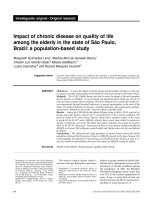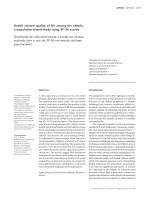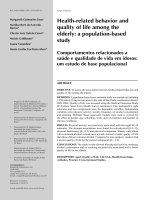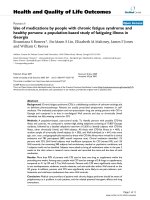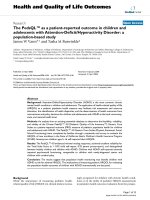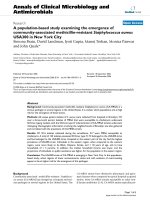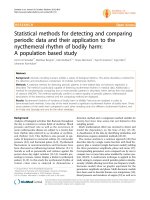A population based study 1
Bạn đang xem bản rút gọn của tài liệu. Xem và tải ngay bản đầy đủ của tài liệu tại đây (755.67 KB, 113 trang )
GENETIC AND EPIGENETIC ALTERATIONS IN THE BRCA1
GENE IN SINGAPORE BREAST AND/OR OVARIAN
CANCER: A POPULATION-BASED STUDY
AZHAR BIN ALI
(B.Sc., Queensland University of Technology)
A THESIS SUBMITTED FOR
THE DEGREE OF DOCTOR OF PHILOSOPHY
DEPARTMENT OF SURGERY
YONG LOO LIN SCHOOL OF MEDICINE
NATIONAL UNIVERSITY OF SINGAPORE
2009
i
ACKNOWLEDGEMENTS
This thesis will not have been possible without the support and guidance from many
people. It is a pleasure to have this opportunity to express my deepest gratitude to all of
them.
First, I would like to thank my PhD supervisor, Dr. Sng Jen-Hwei. I started working for
Dr Sng in 2000 as a research assistant and in 2002; I started my MSc followed by the
PhD program. During these years, her mentorship and guidance in providing sound
advice, ideas and the endless open discussions had been invaluable. She kept an eye on
the progress of my work and was always available when I needed help. Her strict and
extensive comments had a great impact on the final form of this thesis. No words can
describe my deepest gratitude for what she has done.
I would also like to thank my co-supervisor, Dr. Philip Iau Tsau Choong, for his
constructive comments and ideas. Despite his hectic schedule, the support given by him
throughout this work and providing valuable comments on the earlier versions of this
thesis is deeply appreciated. I would also like to thank the members of my PhD
committee who gave valuable comments during my PhD qualifying examination: A/P
Ren EE Chee, A/P Marie Veronique Clement and Dr Ratha Mahendran.
I would like to mention my colleagues, in the Department of Surgery, who shared the
joys and challenges of work and made laboratory life enjoyable. Eugene Lim, Juwita,
Rachel Tham and Shih Wee among others, thank you for not only being good colleagues
ii
but you are great friends as well. And not forgetting the administrative staff in the
Department of Surgery for providing the vital administrative support.
This research work has been supported and funded by National Medical Research
Council. I am grateful to the Singapore Millennium Foundation Limited for providing the
financial support and the good faith shown in me. It would have been impossible for me
to pursue the PhD program without their support.
Pursuing a PhD is a challenge and it is one of the best decisions I have made in my life. I
would also like to thank my family, especially and friends for their support, love and
care. Special thanks to Chan Tuck Wai for his encouragement and the words of wisdom
given to me when I needed them.
I would like to end this acknowledgement with G.K. Charleston’s words; nothing is taken
for granted, everything received with grace, and everything passed on with gratitude.
Thank you all for believing in me.
Azhar Bin Ali
30 October 2007
Singapore
iii
Contents_______________________________________________________ Page
Acknowledgements i
Table of contents iii
List of figures x
List of tables xiii
List of publications/conferences/awards xvi
Abbreviations used in text xviii
Summary xxi
Chapter 1: Introduction 1
1.1. Genetics and epigenetics of cancer 2
1.1.1. Genetics of cancer 2
1.1.1.1. Proto-oncogenes 2
1.1.1.2. Tumour suppressor genes 3
1.1.1.3. Loss of heterozygosity (LOH) 4
1.1.1.4. Haploinsufficiency 6
1.1.2. Epigenetics of cancer 8
1.1.2.1. Epigenetic silencing via methylation in cancer 8
1.1.2.2. Epigenetic silencing via methylation in tumour suppressor
genes 10
1.2. General features of breast, ovarian and fallopian tube carcinomas 14
1.2.1. Breast carcinoma 14
1.2.2. Ovarian carcinoma 20
iv
1.2.3. Fallopian tube carcinoma 23
1.3. The Breast Cancer-Susceptibility Gene, BRCA1 26
1.3.1. BRCA1 Structure 26
1.3.2. Functions of BRCA1 27
1.3.2.1. BRCA1 and regulation of cell proliferation 28
1.3.2.2. BRCA1 and DNA damage repair 29
1.3.2.3. Other functions of BRCA1 32
1.4. BRCA1 and hereditary breast and ovarian cancer 33
1.5. BRCA1 and sporadic breast cancer 35
1.6. Sequence alterations in BRCA1 37
1.6.1. Mutation spectrum 37
1.6.2. Founder mutations 40
1.6.3. Genomic rearrangements 42
1.6.4. Somatic deletions at the BRCA1 locus 44
1.7. Breast and ovarian cancer in Singapore Malay women 44
1.8. Aims of study 46
Chapter 2: Materials and Methods 47
2.1. Materials (Chemicals, reagents and kits) 48
2.2. Study samples 50
2.2.1. BRCA1 mutational analysis (including detection of the recurrent
mutation, c.2845insA) 50
2.2.1.1. Blood specimens 50
2.2.1.2. Paraffin-embedded specimens 53
v
2.2.2. Tissue specimens (BRCA1 promoter hypermethylation study) 55
2.2.3. Cell line 55
2.3. Methods 56
2.3.1. BRCA1 mutational analysis 56
2.3.1.1. Isolation of lymphocytes from blood 56
2.3.1.2. Isolation of genomic DNA 57
2.3.1.2.1. Genomic DNA extraction from lymphocytes 57
2.3.1.2.2. Preparation of genomic DNA from FTA cards 57
2.3.1.2.3. Preparation of genomic DNA from
paraffin-embedded specimens 58
2.3.1.3. Single Strand Conformation Polymorphism (SSCP)
analysis 58
2.3.1.3.1. PCR for SSCP 58
2.3.1.3.2. Agarose gel electrophoresis (DNA) 60
2.3.1.3.3. SSCP gel electrophoresis 61
2.3.1.3.4. Silver staining 64
2.3.1.3.5. Purification of PCR products for sequencing
(using the Wizard® PCR Preps DNA
Purification System) 65
2.3.1.4. Haplotype analysis 65
2.3.1.5. Protein Truncation Test (PTT) analysis 66
2.3.1.5.1. PCR for PTT 66
2.3.1.5.2. In vitro transcription/translation of purified
vi
PCR product (using the TnT® Quick Coupled
Transcription/Translation System) 69
2.3.1.5.3. PTT gel electrophoresis (using SDS-PAGE) 70
2.3.1.6. Genomic rearrangement analysis (using the
MLPA P002 and P087 kits) 71
2.3.2. Methylation analysis of the BRCA1 promoter 73
2.3.2.1. Genomic DNA extraction from tissues 73
2.3.2.2. Total RNA extraction from tissue (using the
RNAgents® Total RNA Isolation System) 74
2.3.2.3. Native agarose gel electrophoresis (RNA) 75
2.3.2.4. Reverse-transcription and PCR (Semi-quantitative) 75
2.3.2.5. Sodium Bisulfite conversion (using the CpGenome™
DNA Modification Kit) 77
2.3.2.6. Methylation-specific PCR (MSP) 79
2.3.2.7. Cloning of the MSP products and transformation (using
the TOPO-TA Cloning System) 80
2.3.2.8. Sequencing (using the BigDye Terminator v3.1
Sequencing Kit) 81
2.3.3. The generation of the BRCA1 c.2845insA construct and
protein expression studies 82
2.3.3.1. Site-directed mutagenesis (using the GeneTailor™
Site-Directed Mutagenesis System) 82
2.3.3.2. Transformation 84
vii
2.3.3.3. Plasmid extraction (using the Wizard® Plus SV
Minipreps DNA Purification System) 85
2.3.3.4. Cell culture 86
2.3.3.4.1. Growth and maintenance 86
2.3.3.4.2. Cell stocks and growth 86
2.3.3.5. Transient transfection (using the lipofectamine
and lipofectamine plus) 87
2.3.3.6. Protein extraction and quantification 88
2.3.3.7. Western blot analysis of BRCA1 c.2845insA
mutant protein 89
2.3.4. Statistical analysis 90
Chapter 3: Results 91
3.1. Genetic alterations of the BRCA1 gene in Singapore Malay women with
breast/ovarian cancer 92
3.1.1. BRCA1 mutations 92
3.1.2. BRCA1 c.284insA mutation, age of onset of cancer and family
history of cancer 95
3.1.3. The recurrent BRCA1 c.2845insA mutation detected in Malay
fallopian tube cancer patient 102
3.1.4. Absence of BRCA1 genomic rearrangement in Malay
breast/ovarian cancer patients 103
3.2. BRCA1 haplotype analysis 105
3.2.1. Haplotyping of Malay breast/ovarian cancer patients and
viii
the general Malay population 105
3.2.2. Identification of a common haplotype at 3 BRCA1 intragenic
markers in breast/ovarian cancer patients with the recurrent
BRCA1 c.2845insA mutation 114
3.2.3. The identification of the recurrent mutation-associated haplotype
identified in a Malay fallopian tube cancer patient 117
3.2.4. Other common haplotypes identified in Malay breast/ovarian
cancer patients 118
3.3. Epigenetic alterations of the BRCA1 gene in sporadic breast cancer 119
3.3.1. BRCA1 promoter hypermethylation 119
3.3.2. Detection of the BRCA1 promoter methylation in paraffin-embedded
breast specimens 122
3.3.3. Loss of heterozygosity (LOH) at the BRCA1 locus 123
3.3.4. Expression of BRCA1 transcript in sporadic breast tumours 124
3.3.5. Summary of epigenetic alterations in the BRCA1 gene in sporadic
breast cancer 126
3.3.6. High-resolution analysis of 29 cytosine residues in the BRCA1
promoter in tumours and their corresponding matched normal
tissues 127
3.4. Site-directed mutagenesis and the in vitro expression of the truncated
BRCA1 c.2845insA protein 131
3.4.1. Generation of BRCA1 c.2845insA mutant 131
3.4.2. Optimal plating density for HCC1937 132
ix
3.4.3. In vitro BRCA1 expression in HCC1937 133
Chapter 4: Discussion 136
4.1 Genetic alterations of the BRCA1 gene in Singapore Malay women with
breast or ovarian cancer 137
4.1.1. BRCA1 mutations 138
4.1.2. Haplotype analysis at the BRCA1 locus 146
4.2. Epigenetic alterations via methylation of the BRCA1 promoter in
Singapore women with sporadic breast cancer 151
4.2.1. Hypermethylation of the BRCA1 promoter, and its association
with LOH and transcript expression 151
4.2.2. BRCA1 promoter methylation in paraffin-embedded breast
specimens 156
4.2.3. Sequence analysis of methylation patterns in the BRCA1
promoter 158
4.3. The generation of functional BRCA1 c.2845insA recombinant
vector 161
4.4. Conclusion 163
Chapter 5: References 166
x
List of figures Page
Chapter 1
Figure 1 Revised Knudson’s two ‘hit’ hypotheses. 13
Figure 2 Age-specific world standardized incidence rates of breast
cancer. 15
Figure 3 Schematic illustration of the BRCA1 protein depicting its three
main domains and associated interacting proteins. 27
Figure 4 DNA damage-induced activation of BRCA1. 30
Figure 5 Top 10 BRCA1 alteration frequencies by designation. 39
Chapter 2
Figure 6 Plan of investigation for the screening of BRCA1 mutations
and haplotype analysis in Singapore Malay women with
breast/ovarian cancer. 51
Figure 7 Plan of investigation for the hypermethylation of BRCA1 promoter,
the association between methylation and transcript analysis and the
analysis of methylation patterns. 54
Figure 8 General overview of the Single Strand Conformation
Polymorphism (SSCP) technique. 60
Figure 9 A schematic diagram of the protein truncation test (PTT). 68
Figure 10 General overview of the MLPA principle. 73
Figure 11 A schematic diagram of the wild-type BRCA1 construct. 82
Chapter 3
Figure 12 The recurrent BRCA1 c.2845insA deleterious mutation identified
xi
in six Malay breast and ovarian cancer patients. 96
Figure 13 Ten BRCA1 genetic variants detected in Malay women
with breast/ovarian cancer by SSCP. 101
Figure 14 Detection of the recurrent BRCA1 c.2845insA mutation in a
Malay fallopian tube cancer patient (N633) together with five
other family members (N655, N671, N644, N651 and N662). 102
Figure 15 Recurrent BRCA1 c.2845insA mutation analysis of a Malay
fallopian tube cancer patient with five other family members. 103
Figure 16 Electrophoregrams showing profiles of a Malay breast
cancer patient, N510, and a novel BRCA1 rearrangement
identified in an ovarian cancer patient of Indian ethnicity. 104
Figure 17 A representation of the haplotype analysis in 3 breast cancer
patients. 106
Figure 18 Allele distribution of the D17S1323 (BRCA1 Intron 12) marker
in Singapore Malay women with breast/ovarian cancer. 107
Figure 19 Allele distribution of the D17S1322 (BRCA1 Intron 19) marker
in Singapore Malay women with breast/ovarian cancer. 109
Figure 20 Allele distribution of the D17S855 (BRCA1 Intron 20) marker
in Singapore Malay women with breast/ovarian cancer. 112
Figure 21 Methylation-specific PCR of the BRCA1 promoter of matched
non-tumour and tumour tissues in sporadic breast cancer
patients. 120
Figure 22 Column (scatter) graph depicting the proportion of
xii
methylation in matched non-tumour and tumour tissues of 23
sporadic breast cancer patients. 122
Figure 23 Methylation-specific PCR of the BRCA1 promoter in paraffin-
embedded breast tissue from a Malay female patient. 123
Figure 24 LOH analyzed at 3 BRCA1 intragenic markers in matched
non-tumour and tumour breast tissue samples. 124
Figure 25 Semi-quantitative reverse-transcription PCR of BRCA1 in breast
tumours with BRCA1 promoter hypermethylation or/and LOH. 125
Figure 26 Electrophoregram depicting the insertion of an adenosine
residue by site-directed mutagenesis to create BRCA1
c.2845insA mutant using a BRCA1 wild-type construct. 132
Figure 27 Growth curve of the HCC1937 cell line. 133
Figure 28 In vitro luciferase activity (pGL) in HCC1937 cell line. 134
Figure 29 Western blots showing the expression of BRCA1 wild-type
(220kDa) and BRCA1 c.2845insA mutant protein (106kDa) in
HCC1937 after transfection (for 48 and 72 hrs). 135
xiii
List of tables Page
Chapter 1
Table 1 Staging of breast cancer by TMN classification according to the
American Joint Committee on Cancer. 19
Table 2 General staging of ovarian cancer according to FIGO and the
International Gynecologic Cancer Society. 22
Table 3 General staging of fallopian tube cancer according to FIGO
and the International Gynecologic Cancer Society. 25
Chapter 2
Table 4 Primer sequences for SSCP analysis of BRCA1, their respective annealing
temperatures and electrophoresis conditions. 62
Table 5 Primer sequences for BRCA1 haplotype analysis. 66
Table 6 Primer sequences for the PTT analysis of BRCA1. 69
Chapter 3
Table 7 Summary of BRCA1 genetic/epigenetic study samples. 93
Table 8 BRCA1 mutations found in Singapore Malay women with breast/
ovarian cancer. 94
Table 9 BRCA1 mutations in Malay patients with family history of cancer. 97
Table 10 BRCA1 mutations in Malay patients without or unknown family
history of cancer. 100
Table 11 Allele distribution of the D17S1323 (BRCA1 Intron 12) in
Singapore Malay women with breast/ovarian cancer. 108
Table 12 Allele distribution of the D17S1322 (BRCA1 Intron 19) in
xiv
Singapore Malay women with breast/ovarian cancer. 110
Table 13 Allele distribution of the D17S855 (BRCA1 Intron 20) in
Singapore Malay women with breast/ovarian cancer. 113
Table 14 Genotyping at D17S1323, D17S1322 and D17S855 in Malay
breast/ovarian cancer with the recurrent BRCA1 c.2845insA
mutation. 114
Table 15 Common haplotypes (159-127-142 for D17S1323-D17S1322
-D17S855 respectively) in Singapore Malay women with
breast/ovarian cancer. 116
Table 16 Genotyping of Malay fallopian tube cancer patient with
the recurrent BRCA1 c.2845insA mutation together with five of
her family members. 117
Table 17 Identification of other haplotypes in Malay women with
breast/ovarian cancer. 118
Table 18 Methylation-specific PCR (MSP) of the BRCA1 promoter in
matched non-tumour and tumour tissue from twenty-three
sporadic breast cancer patients. 121
Table 19 BRCA1 promoter hypermethylation, LOH, mutation status and
mRNA expression in 23 sporadic breast cancer patients. 127
Table 20 Methylation status of 29 cytosine residues in BRCA1 promoter
hypermethylated tumours. 129
Table 21 Methylation status of 29 cytosine residues in BRCA1 promoter in
matched non-tumour tissues from patients with BRCA1
xv
promoter hypermethylation. 130
Table 22 A summary table showing the methylation status of cytosine
residues within the BRCA1 promoter in hypermethylated and
corresponding matched non-tumour tissues. 131
xvi
List of publications/conferences/awards
Publications:
1. Jen-Hwei Sng, Azhar bin Ali, Soo Chin Lee, Damayanti Zahar, John Eu-Li Wong,
V Blake, A Sharif, Gareth Cross and Philip Tsau Choong Iau: BRCA1 c.2845insA is a
recurring mutation with a founder effect in Singapore Malay women with early onset
breast/ovarian cancer. Journal of Medical Genetics, 40(10):E117, 2003
2. Zahar Damayanti, Azhar bin Ali, Philip Tsau Choong Iau, A. Ilancheran and Jen-
Hwei Sng. The founder mutation BRCA1 c.2845insA identified in a fallopian tube
cancer patient: a case report. International Journal of Gynecological Cancer, 16:
362-365, 2006
3. Yew Koon Lim, Philip Tsau Choong Iau, Azhar bin Ali, Soo Chin Lee, John Eu-Li
Wong, Thomas Choudary Putti and Jen-Hwei Sng. Identification of novel BRCA large
genomic rearrangements in Singapore Asian breast and ovarian cancer patients.
Clinical Genetics, 71: 331-342, 2007
4. Azhar bin Ali, Philip Tsau Choong Iau, Thomas Choudary Putti and Jen-Hwei Sng.
BRCA1 disease-associated haplotypes in Singapore Malay women with early-onset
breast/ovarian cancer. Breast Cancer Research and Treatment, 104: 351-353, 2007
xvii
Conferences:
1. BRCA1 2841/5insA is a recurring mutation with a founder effect in Singapore
Malay women with early onset breast/ovarian cancer. 8
th
Nottingham International
Breast Cancer Conference, Nottingham, United Kingdom. 16-19 September 2003.
Published in European Journal of Cancer Sept. 2003; Suppl. Vol. 1 Nos. 4: p33.
2. BRCA1 c.2845insA is a founder mutation in Singaporean Malay women with early
onset breast/ovarian cancer. National Healthcare Group (NHG) Annual Scientific
Congress, Singapore. 4-5 October 2003. Published in Annals Academy of Medicine
Singapore September 2003; Vol. 32 (suppl) No. 5: S53
3. Genomic rearrangement in BRCA1 among Singapore women with breast and/or
ovarian cancer. 5
th
Human Genetics Organization (HUGO) pacific Meeting & 6
th
Asia-Pacific Conference on Human Genetics, Biopolis, Singapore. 17-20
November 2004.
4. Epigenetic alterations in tumor suppressor genes among non-familial breast
carcinomas. 11
th
International Conference of Human Genetics, Brisbane,
Australia. 6-10 August 2006.
Awards:
Singapore Millenium Foundation MSc and PhD scholarship from August 2002 to
July 2007.
xviii
Abbreviations used in text
AA Amino Acid
APC Adenomatous Polyposis Coli
ATM Ataxia-Telangiectasia Mutated
ATP Adenosine Triphosphate
ATR Ataxia-Telangiectasia and RAD3-Related
BARD1 BRCA1-Associated Ring Domain 1
BASC BRCA1-Associated Surveillance Complex
BIC Breast Information Core
BRCA1 Breast Cancer Type 1
BRCA2 Breast Cancer Type 2
BRCT BRCA1 C-Terminus
Brn-3b POU-Domain Transcription Factor BRN3b
BSA Bovine Serum Albumin
cAMP Cyclic Adenosine Monophosphate
CBP CREB-Binding Protein
c-Myc Avian Myelocytomatosis Virus Oncogene
CALCA Calcitonin/Calcitonin-Related Polypeptide, Alpha
CBFA2 Core-Binding Factor, Runt Domain, Alpha Subunit 2
CDH1 Epithelial cadherin
CDK4 Cyclin-Dependent Kinase 4
CHK2 Checkpoint Kinase 2
CI Confidence Interval
CMV Cytomegalovirus
CRE cAMP Response Elements
CREB cAMP Response Binding-Element
CRC Colorectal Cancer
CtIP C-terminal binding protein-interacting protein
DBD DNA Binding Domain
DEPC Diethylpyrocarbonate
DMSO Dimethyl Sulfoxide
DNA Deoxyribonucleic Acid
DNMT DNA Methyltransferase
dNTP Deoxynucleotide Triphosphate
DSB Double-Stranded Break
EDTA Ethylenediaminetetraacetic Acid
ER Estrogen Receptor
FBS Fetal Bovine Serum
FIGO Federation Internationale de Gynecologie et d’Obstetrique
FPD/AML Familial Platelet Disorder/ Acute Myeloid Leukaemia
GABPα/β GA-Binding Protein alpha/beta
GADD45 DNA Damage Inducible Protein
GAL4 Galactose Metabolism
GIST Gastrointestinal Stromal Tumour
GSTP1 Glutathione S-Transferase, P1
xix
H2A Phosphorylated Histone
HA Haemagglutinin
HDAC Histone Deacetylase
HDGC Hereditary Gastric Cancer
HLA-B Major histocompatibility complex, class I, B
HLA-DR β1 Major histocompatiibility complex, class II, cell surface receptor
HPRC Hereditary Papillary Renal Carcinoma
hMRE11 Human Meiotic Recombination 11
HR Homologous Recombination
hRAD50 Human Recombination Protein 50
IARC International Agency for Research on Cancer
Id4 Inhibitor of DNA Binding 4
IGF2 Insulin-like Growth Factor II
JNK c-Jun N-terminal Kinase
KIT V-Kit Hardy-Zuckerman 4 Feline Sarcoma Viral Oncogene Homolog
LB Luria-Bertani
LKB1 Serine Threonine Protein Kinase 11
LOH Loss of Heterozygosity
MBD Methyl-CpG Binding Domain
MeCP2 Methyl CpG Binding Protein 2
MDE Mutation Detection Enhancement
MET MET Proto-Oncogene
MGMT O
6
-Methylguanine DNA Methyltransferase
MHC Major histocompatibility complex
MLH1 MutL Homolog 1
MLPA Multiplex Ligation Probe Amplification
mRNA Messenger RNA
MSI Microsatellite Instabiity
MSP Methylation-Specific PCR
MyoD Myosin D
NBS1 Nijmegen Breakage Syndrome 1
NHEJ Non-Homologous End Joining
NLS Nuclear Localisation Sequence
OMIM Online Mendelian Inheritance in Man
OR Odds Ratio
ORF Open Reading Frame
p21 Cyclin-Dependent Kinase Inhibitor
p53 Tumour Protein 53
PCR Polymerase Chain Reaction
PBS Phosphate Buffered Saline
PMSF Phenylmethylsulfonyl Fluoride
PTEN Phosphatase and Tensin Homolog
PTT Protein Truncation Test
RB Retinoblastoma
RAD51 Recombination Protein 51
RbAp Retinoblastoma-Associated Proteins
xx
Rb-E2F Retinoblastoma-E2F
RET Rearranged During Transfection Proto-Oncogene
RHA RNA Helicase A
RING Really Interesting New Gene
RLU Relative Light Unit
RNA Ribonucleic Acid
RR Relative Risk
SAM S-adenosylmethionine
SCD SQ/TQ Cluster Domain
SDS Sodium Dodecyl Sulfate
SDS-PAGE Sodium Dodecyl Sulfate – Polyacrylamide Gel Electrophoresis
SEM Standard Error Mean
SIN3 SWI-Independent 3
SNP Single Nucleotide Polymorphism
SSCP Single Strand Conformation Polymorphism
SWI-SNF Human Switching-Deficient Sucrose Non-Fermenting
TBE Tris-Borate EDTA
TE Tris-EDTA
TEMED Tetramethylethylenediamine
TGF-β1 Transforming Growth Factor beta 1
TMN Tumour, Node and Metastasis
TNF Tumour Necrosis Factor
TSGs Tumour Suppressor Genes
UV Ultraviolet
VHL Von Hippel-Lindau
γ-H2AX Phosphorylated Histone H2AX
xxi
Summary
Among the major three ethnic groups in Singapore, the Malays have shown the greatest
increase in the incidence of breast cancer over the past three decades. Another attribute of
the Singapore Malays is their relatively homogenous structure due to low inclination
towards migration and they tend to marry within their ethnic group. In addition, a
recurrent BRCA1 mutation, c.2845insA, has been identified in Malay women with early-
onset breast cancer. Prior to this study, limited data was available on the genetic and
epigenetic BRCA1 alterations in Singapore breast and/or ovarian cancers.
The aim of this study was to investigate genetic alterations of the BRCA1 gene in
Singapore Malay women with breast and/or ovarian cancer. In addition, epigenetic
alteration, in the form of promoter hypermethylation, in BRCA1 was examined in
Singapore women with sporadic breast cancer. LOH at the BRCA1 locus was also
assessed in these cases. Methylation at the cytosine residues within the BRCA1 promoter
was studied to identify cancer-specific methylation patterns in primary breast tumours.
Mutational analysis of the entire coding region and adjacent intronic segments of the
BRCA1 gene revealed 12 distinct alterations in which five of these alterations are novel.
A positive family history of breast/ovarian cancer and younger age of onset of cancer
appear to be good predictors of presence of BRCA1 mutation. The recurrent BRCA1
c.2845insA mutation was detected in 2.5% (6/236) of all cancer cases and haplotyping at
3 BRCA1 intragenic markers revealed a common haplotype in all recurrent mutation
carriers, strongly suggesting that BRCA1 c.2845insA is a founder mutation. Moreover,
xxii
two other common haplotypes were identified in the BRCA1 c.2845insA negative
breast/ovarian cancer patients.
Results from methylation analysis of the BRCA1 promoter revealed hypermethylation
together with reduced BRCA1 expression in 23.8% (8/23) of sporadic breast cancer
patients. LOH, a hallmark commonly observed in breast tumours, was detected in 39.1%
(9/23) of all tumours analyzed. No correlation was found between the hypermethylation
status and LOH at the BRCA1 locus. However, in more than 50% of the tumours
analyzed, only one BRCA1 allele was found to be affected by either LOH or promoter
hypermethylation suggesting that these tumours could have formed due to either
haploinsufficiency or transcriptional silencing of the BRCA1 gene. Differences in BRCA1
methylation patterns were observed between tumours and corresponding non-tumour
tissues where the methylation levels of cytosine residues in tumours were much higher
than in normal tissues. Together, these results indicate that DNA methylation within the
BRCA1 promoter can be exploited as a marker to identify women at risk of developing
breast cancer. However, this requires further investigation.
1
Chapter 1:
Introduction
2
1.1. Genetics and epigenetics of cancer
Carcinogenesis is a multi-step process where genetic and epigenetic alterations
accumulate in a single cell that ultimately transforms it into a cancer cell. The
transformed cell normally acquires a clonal growth advantage over the surrounding cells,
subsequently producing genetically and biologically abnormal daughter cells. This clonal
progression model of cancer indicates that several changes are required in a given cell for
cancer formation (Nowell PC, 1976). Tumours are usually characterised by aberrations in
the chromosomes and multiple genes, some of which have essential roles in
tumourigenesis. The genes found involved in cancer affect important cellular processes
such as proliferation, cell to cell communication, angiogenesis, apoptosis,
deoxyribonucleic acid (DNA) repair, senescence, genomic stability and motility
(Compagni A and Christofori G, 1996; Hanahan D and Weinberg RA, 2000; Evan GI and
Voudsen KH, 2001; Ponder BA, 2001).
1.1.1. Genetics of cancer
Two major classes of genes are known to be involved in cancer: proto-oncogenes and
tumour suppressor genes.
1.1.1.1 Proto-oncogenes.
Proto-oncogenes have essential roles in normal cell proliferation, apoptosis and
differentiation. Inappropriate activations via a variety of mechanisms such as
chromosomal translocation resulting in gene recombination, point mutations resulting in
an altered protein product or amplification resulting in overexpression of the oncoprotein
